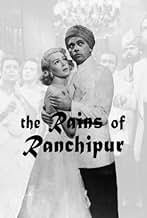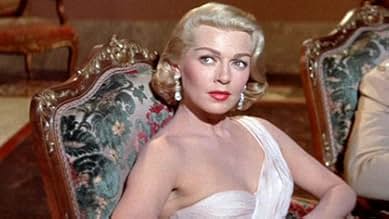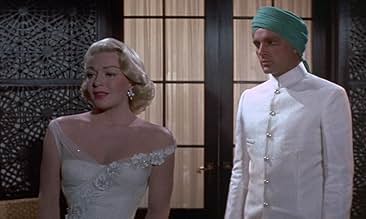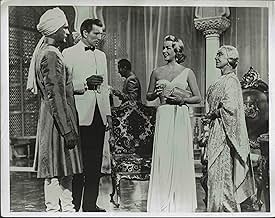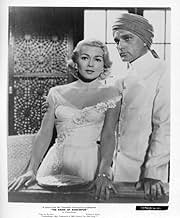NOTE IMDb
5,8/10
1,2 k
MA NOTE
Ajouter une intrigue dans votre langueDespite marital problems, English Lord Albert Esketh and his rich American socialite wife Lady Edwina Esketh travel to India to buy a prize horse from the ruler of Ranchipur.Despite marital problems, English Lord Albert Esketh and his rich American socialite wife Lady Edwina Esketh travel to India to buy a prize horse from the ruler of Ranchipur.Despite marital problems, English Lord Albert Esketh and his rich American socialite wife Lady Edwina Esketh travel to India to buy a prize horse from the ruler of Ranchipur.
- Réalisation
- Scénario
- Casting principal
- Nommé pour 1 Oscar
- 1 nomination au total
Rama Bai
- Lachmaania
- (non crédité)
John Banner
- Rashid Ali Khan
- (non crédité)
Jugat Bhatia
- Headhunter
- (non crédité)
George Brand
- Mr. Simon
- (non crédité)
Argentina Brunetti
- Mrs. Adoani
- (non crédité)
King Calder
- Mr. Smiley
- (non crédité)
Jack Deery
- Party Guest
- (non crédité)
Paul Frees
- Sundar
- (non crédité)
Avis à la une
Oh, dear! One of my favorite mid-Fifties Twentieth-Century Fox CinemaScopuses was nearly ruined for me a few years back when Bette Midler released her comedy album, "Mud WILL Be Flung, Tonight!" in which she does an elaborate routine in her character as "Soph" in bed with her boyfriend, "Ernie" who excuses himself to use the loo. When she hears certain sounds emanating from the bathroom, upon his return to the boudoir she demands: "Ernie, what the hell was that?!?" and he advises: "Soph, those were the Rains of Raunch-I-Poor!!" The routine goes on to appropriate a few other famous movie titles like "The Snows of Kilimanjaro," "The Winds of Krakatoa" (i.e., "Krakatoa, East of Java")...well, you get the idea, I would guess!
Anyway, Ms. Midler, no respecter of popular culture when it comes to her usually successful attempts at camp humor in her standup comedy routines, probably enjoyed this elaborate remake as much as I did, if she's ever seen it. 20th-Century Fox assembled a nicely balanced cast and assigned some top-flight professionals to give the whole thing the kind of gloss that's pretty much a thing of the past now. Of special note are the Academy Award-nominated special effects, rather convincing when I saw this on a big CinemaScope screen; some very nice use of DeLuxe Color (everyone looks handsome indeed, especially Miss Turner); and Hugo Friedhofer's tasteful score. (He was a composer who always successfully resisted producers' attempts to add music to an excessively gloppy extent and he was often astute in adding an exotic touch, where appropriate, with just a few bars of orchestration.) By the way I don't think, contrary to another comment here, that the production sent a second unit to Pakistan or anywhere outside of California. I might be wrong, since the opening sequence with Lord and Lady Esketh arriving by train into a bustling Indian metropolis is a terrific example of Hollywood fakery if it's not the real thing. There's one brief shot, however, where a limousine is seen turning into the supposed gates of the Maharani's compound and it is unmistakably the West Gate of Bel-Air, one of West Los Angeles' poshest subdivisions.
Anyway, Ms. Midler, no respecter of popular culture when it comes to her usually successful attempts at camp humor in her standup comedy routines, probably enjoyed this elaborate remake as much as I did, if she's ever seen it. 20th-Century Fox assembled a nicely balanced cast and assigned some top-flight professionals to give the whole thing the kind of gloss that's pretty much a thing of the past now. Of special note are the Academy Award-nominated special effects, rather convincing when I saw this on a big CinemaScope screen; some very nice use of DeLuxe Color (everyone looks handsome indeed, especially Miss Turner); and Hugo Friedhofer's tasteful score. (He was a composer who always successfully resisted producers' attempts to add music to an excessively gloppy extent and he was often astute in adding an exotic touch, where appropriate, with just a few bars of orchestration.) By the way I don't think, contrary to another comment here, that the production sent a second unit to Pakistan or anywhere outside of California. I might be wrong, since the opening sequence with Lord and Lady Esketh arriving by train into a bustling Indian metropolis is a terrific example of Hollywood fakery if it's not the real thing. There's one brief shot, however, where a limousine is seen turning into the supposed gates of the Maharani's compound and it is unmistakably the West Gate of Bel-Air, one of West Los Angeles' poshest subdivisions.
For those among us who grew up watching a lot of television in the 1960s,it's always a lot of fun seeing stars doing supporting roles earlier in their careers.And who's doing the bluff,hearty,amiable Sikh police captain?None other than John Banner,who went on to do the comic heavy Schultz,on"Hogan's Heroes."And,for all of his teutonic ponderousness,he does manage to carry it off.
The original film on which The Rains Of Ranchipur is a remake, The Rains Came share one thing in common. The Rains Came won the second Oscar given in the category of Best Special Effects and The Rains Of Ranchipur was nominated in the same category. But other than that while the first was a tidal flood of emotions this one barely registers a drizzle.
Unhappily married Michael Rennie and Lana Turner come on holiday to the Indian province of Ranchipur. He married her money, she married his title and she's had a long string of affairs in both hemispheres that always make the gossip columns. She takes one look at Hindu doctor Richard Burton and decides he will be her latest conquest. She also meets another of her former conquests Fred MacMurray who is living out here on his inheritance and who missionary kid Joan Caulfield decides he's got the makings of a reformation project.
That's about how the original film is laid out. But the changes and softenings of the story and the characters make The Rains Of Ranchipur lose all its punch. The biggest changes are to the characters that Lana Turner and Michael Rennie play who were essayed by Myrna Loy and Nigel Bruce in the original. See the two side by side and you'll know what I mean. In addition Joan Caulfield is way too old to be playing college age girls. Her part in the original is done by Brenda Joyce.
Color has been added and some nice location cinematography of India during its first decade of independence is nice to see as well as the earthquake and flooding sequences. It makes up for a watered down story.
Unhappily married Michael Rennie and Lana Turner come on holiday to the Indian province of Ranchipur. He married her money, she married his title and she's had a long string of affairs in both hemispheres that always make the gossip columns. She takes one look at Hindu doctor Richard Burton and decides he will be her latest conquest. She also meets another of her former conquests Fred MacMurray who is living out here on his inheritance and who missionary kid Joan Caulfield decides he's got the makings of a reformation project.
That's about how the original film is laid out. But the changes and softenings of the story and the characters make The Rains Of Ranchipur lose all its punch. The biggest changes are to the characters that Lana Turner and Michael Rennie play who were essayed by Myrna Loy and Nigel Bruce in the original. See the two side by side and you'll know what I mean. In addition Joan Caulfield is way too old to be playing college age girls. Her part in the original is done by Brenda Joyce.
Color has been added and some nice location cinematography of India during its first decade of independence is nice to see as well as the earthquake and flooding sequences. It makes up for a watered down story.
A quaint film. shot in Pakistan about events in India. Ranchipur is a fictional kingdom of undivided India, Richard Burton plays a brown skinned South Asian. He does a fairly good job except when he speaks Urdu/Hindi to the native patients and servants.
The main actors played the roles in Hollywood not in Pakistan. The earthquake and street scenes are very realistic for a 1955 film. It certainly deserved the Special Effects Oscar nomination it bagged.. There was an earlier 1930 version of the film scripted by Philip Dunne, where the Lana Turner character dies. That decision to remove the death from the script of the later Negulesco version definitely weakened it as it reiterates the Lana Turner character Edwina as woman who had affairs and dropped them in due course. Had that change not been made the film would have been remarkable. Even the cobra in the film is a real one, not a prop.
As an Indian, I admired the performance of Eugenie Leontovich as the Maharani as she spoke like an Indian maharani would despite her awful wig.
This is one of the rare films of the Fifties showing inter-racial relationships.
The main actors played the roles in Hollywood not in Pakistan. The earthquake and street scenes are very realistic for a 1955 film. It certainly deserved the Special Effects Oscar nomination it bagged.. There was an earlier 1930 version of the film scripted by Philip Dunne, where the Lana Turner character dies. That decision to remove the death from the script of the later Negulesco version definitely weakened it as it reiterates the Lana Turner character Edwina as woman who had affairs and dropped them in due course. Had that change not been made the film would have been remarkable. Even the cobra in the film is a real one, not a prop.
As an Indian, I admired the performance of Eugenie Leontovich as the Maharani as she spoke like an Indian maharani would despite her awful wig.
This is one of the rare films of the Fifties showing inter-racial relationships.
Lord Esketh, a British aristocrat, and his glamorous American wife, Edwina, are touring India and staying in the city of Ranchipur, where they are guests of the local Maharani. (The action is supposed to be set in India, even though we see a prominently displayed Pakistani flag in an early scene). Their marriage is an unhappy one and each despises the other. Edwina despises her husband because she sees him as weak and cowardly and because he only married her for her money. (She is an independently wealthy heiress). He despises her because he sees her as cold and heartless; we learn that she has been unfaithful to him with a number of different men. While in Ranchipur Edwina meets and has an affair with a young suntanned Welshman in a turban.
Well, actually Richard Burton's character is supposed to be an Indian, Dr Safti, a physician and the adopted son of the Maharani. Today, the idea of a white actor in "brownface" playing an Indian would strike most people as politically incorrect, but was an accepted practice in the fifties, and at least Burton's performance is a lot less insensitive than that given by Peter Sellers in "The Millionairess" from a few years later. (Sellers was also playing an Indian doctor). Watching the film, I wondered if the use of the Christian name "Edwina" was a veiled reference to Edwina Mountbatten, another independently wealthy heiress, married to a British aristocrat, who visited India and was rumoured to have had an affair with an Indian man, in her case the politician Jawaharlal Nehru. I understand, however, that "The Rains of Ranchipur" is a remake of "The Rains Came" from 1939 (which I have never seen), and that the character had the same name both in this film and in the 1937 novel on which it was based. As the Mountbattens did not come to India until 1947, the coincidence was presumably unintentional.
The Edwina-Safti romance is the mainspring of the plot, but for all Edwina's good looks she is so obviously spoilt, selfish and promiscuous that it is difficult to imagine any man, let alone one as intelligent and idealistic as Dr Safti, falling hopelessly in love with her. There is a subplot involving another romance between Tom Ransome, an alcoholic former lover of Edwina and close friend of Safti, and Fern, the daughter of a local missionary, but this arouses little interest.
The acting is generally undistinguished. Burton, as though embarrassed by having been cast in a role to which he was ill-suited, is horribly stilted and wooden, giving by far his worst performance in any film of his which I have seen. The Russian-born Eugenie Leontovich as the Maharani is no more convincing as an Indian than is Burton. Lana Turner as Edwina and Fred MacMurray as Tom were both capable of much better things than this. Probably the best is Joan Caulfield as Fern. The intention seems to have been to contrast Fern's youth and innocence with the cynicism and corruption of the experienced older woman Edwina, so it is perhaps surprising that Caulfield, who at 33 was only a year younger than Turner, was cast in the role, but she is fresh and youthful-looking enough to succeed in making the contrast an effective one.
The best thing about the film is its special effects. Although "The Rains of Ranchipur" is not a "disaster movie" in the sense that the film-makers of the seventies would have understood the term, an earthquake and the subsequent flood after the earthquake destroys a dam play important roles in the story. These scenes are very well done, are still convincingly impressive even in the era of CGI and the main reason why I have given the film an average mark. Unfortunately, there is little else to make the film worth watching today. Special effects apart, it is the sort of dull, turgid and implausible melodrama which typified Hollywood at its worst during the fifties. 5/10
Well, actually Richard Burton's character is supposed to be an Indian, Dr Safti, a physician and the adopted son of the Maharani. Today, the idea of a white actor in "brownface" playing an Indian would strike most people as politically incorrect, but was an accepted practice in the fifties, and at least Burton's performance is a lot less insensitive than that given by Peter Sellers in "The Millionairess" from a few years later. (Sellers was also playing an Indian doctor). Watching the film, I wondered if the use of the Christian name "Edwina" was a veiled reference to Edwina Mountbatten, another independently wealthy heiress, married to a British aristocrat, who visited India and was rumoured to have had an affair with an Indian man, in her case the politician Jawaharlal Nehru. I understand, however, that "The Rains of Ranchipur" is a remake of "The Rains Came" from 1939 (which I have never seen), and that the character had the same name both in this film and in the 1937 novel on which it was based. As the Mountbattens did not come to India until 1947, the coincidence was presumably unintentional.
The Edwina-Safti romance is the mainspring of the plot, but for all Edwina's good looks she is so obviously spoilt, selfish and promiscuous that it is difficult to imagine any man, let alone one as intelligent and idealistic as Dr Safti, falling hopelessly in love with her. There is a subplot involving another romance between Tom Ransome, an alcoholic former lover of Edwina and close friend of Safti, and Fern, the daughter of a local missionary, but this arouses little interest.
The acting is generally undistinguished. Burton, as though embarrassed by having been cast in a role to which he was ill-suited, is horribly stilted and wooden, giving by far his worst performance in any film of his which I have seen. The Russian-born Eugenie Leontovich as the Maharani is no more convincing as an Indian than is Burton. Lana Turner as Edwina and Fred MacMurray as Tom were both capable of much better things than this. Probably the best is Joan Caulfield as Fern. The intention seems to have been to contrast Fern's youth and innocence with the cynicism and corruption of the experienced older woman Edwina, so it is perhaps surprising that Caulfield, who at 33 was only a year younger than Turner, was cast in the role, but she is fresh and youthful-looking enough to succeed in making the contrast an effective one.
The best thing about the film is its special effects. Although "The Rains of Ranchipur" is not a "disaster movie" in the sense that the film-makers of the seventies would have understood the term, an earthquake and the subsequent flood after the earthquake destroys a dam play important roles in the story. These scenes are very well done, are still convincingly impressive even in the era of CGI and the main reason why I have given the film an average mark. Unfortunately, there is little else to make the film worth watching today. Special effects apart, it is the sort of dull, turgid and implausible melodrama which typified Hollywood at its worst during the fifties. 5/10
Le saviez-vous
- AnecdotesLa mousson (1955) was originally to be shot on location in both India and Pakistan. Modern sources claim that India refused to grant the studio a filming permit, however, and contemporary sources reported that backgrounds for the picture were shot on location in Pakistan only. Some location shooting was also done on the Twentieth Century-Fox ranch in Malibu, CA. Principal players never left Hollywood. Doubles filled in for the main cast in the long shots and whatever other scenes that were needed.
- ConnexionsEdited into Notre homme Flint (1966)
Meilleurs choix
Connectez-vous pour évaluer et suivre la liste de favoris afin de recevoir des recommandations personnalisées
- How long is The Rains of Ranchipur?Alimenté par Alexa
Détails
Box-office
- Budget
- 4 500 000 $US (estimé)
- Durée1 heure 44 minutes
- Rapport de forme
- 2.55 : 1
Contribuer à cette page
Suggérer une modification ou ajouter du contenu manquant

